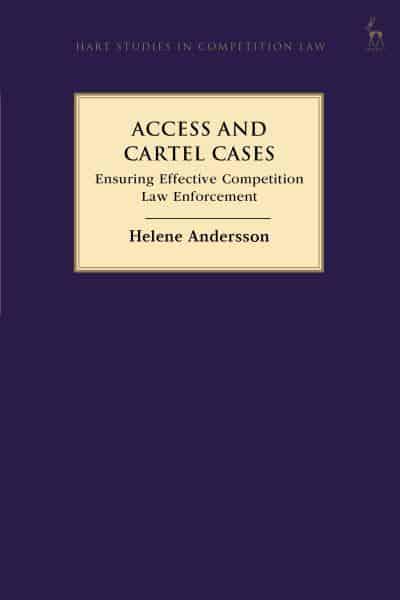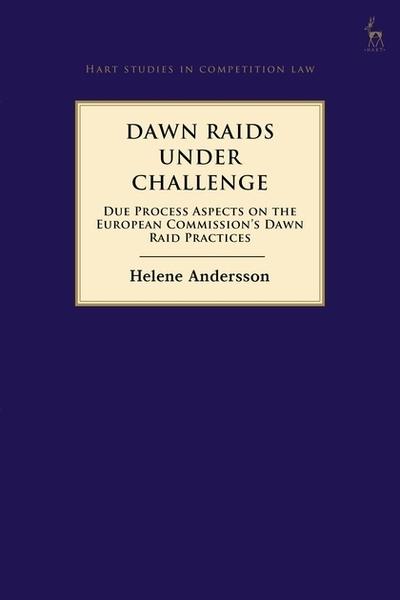Access and cartel cases
ensuring effective competition law enforcement
- ISBN: 9781509942527
- Editorial: Hart Publishing
- Fecha de la edición: 2023
- Lugar de la edición: Oxford. Reino Unido
- Colección: Hart Studies in Competition Law
- Encuadernación: Rústica
- Medidas: 24 cm
- Nº Pág.: 320
- Idiomas: Inglés

This book examines the legislative patchwork surrounding access to the European Commission's cartel case files. Recent legislative changes have increased the value of the files and have also highlighted the inherent tension between a number of competing interests affecting their accessibility. The Commission is undoubtedly caught between a rock and a hard place, charged with the task to ensure due process, transparency and effectiveness while at the same time promoting both public and private enforcement of the EU competition rules. The author considers how best to ensure a proper balance between the legitimate, but often diverging interests of parties, third parties and national competition authorities in these cases. The book provides a unique and comprehensive presentation of the EU legislation and case law surrounding access to the Commission's cartel case files. The author examines the question of accessibility from three different perspectives: that of the parties under investigation, cartel victims, and national competition authorities. The author also considers the EU leniency system and whether any legislative changes could make the attractiveness of the system less dependent on the possibilities of cartel victims to access the evidence contained in the Commission's case files.
Introduction
I. Aim and Scope of this Book
II. Setting the Scene
III. Outline
PART I
THE LEGISLATIVE FRAMEWORK
1. The Rules Governing Access
I. Public Access to Documents Held by the EU Institutions
2. Fundamental Rights Protection in the EU
I. Historic Background to EU Fundamental Rights Protection
II. The Role of the ECHR within the EU Fundamental Rights Regime
III. The Criminal Nature of Competition Law Proceedings
IV. The Legal Framework Surrounding Party Access
PART II
NATIONAL COMPETITION AUTHORITIES
3. Information Exchange between Competition Authorities
I. Information Exchange – A Sine Qua Non of Effective Cartel Enforcement?
II. The Territorial Reach of EU Competition Law
III. Safeguarding Fundamental Rights
IV. Cooperation Reaching Outside the EU
V. Information Exchange Within the ECN
VI. Information Exchange – Concluding Remarks
PART III
PARTIES AND COMPLAINANTS
4. Targeted Companies' Right to Access the File
I. Access to the File – Emergence of the Right
II. Access to the File – The Legislative Framework
III. When Should Access be Granted?
V. Consequences of the Commission's Failure to Grant Access
VI. The Parties' Use of the Information Obtained from the Commission
VII. Does the EU Standard Meet the ECHR Standard?
VIII. Access to the File – Concluding Remarks
5. Third Parties' Right to Access Documents in the Capacity of Complainants or Interveners
I. The Regulatory Framework
II. The Courts' Case Law
III. Concluding Remarks
PART IV
THIRD PARTIES AND THE ROLE OF THE LENIENCY PROGRAMME
6. Seeking Access under the Transparency Regulation
I. Seeking Direct Access to the Commission's File
II. The Courts' Case Law
7. Seeking Access Through National Courts
I. The Commission and the National Courts before the Damages Directive
II. The Commission and the National Courts aft er the Directive
III. International Aspects
IV. Concluding Remarks
8. More Detailed Infringements Decisions – The Way Forward?
I. The Procedure
II. Pergan Hilfsstoff e – Professional Secrecy and the Presumption of Innocence
III. AKZO – (Non-) Protection of Leniency Applicants
IV. Pilkington – Information Shared between Cartel Members No Longer Confidential
V. Evonik Degussa – Protection of Leniency Statements
VI. The Court's Ruling in AGC Glass – The Role of the Hearing Officer
VII. More Detailed Infringements Decisions – Concluding Remarks
9. The Survival of the Leniency System
I. The EU Leniency System
II. Necessary Features in a Successful Leniency Programme
III. Why Decide against Filing a Leniency Application?
IV. Are We Really Witnessing the Decline and Fall of the EU Leniency Programme?
V. Is Leniency the Only Option?
VI. Keeping the Leniency Programme Attractive
VII. The US Experience
VIII. The Survival of the Leniency System – Concluding Remarks
PART V
SUMMING UP
10. Joining the Dots
I. Information Exchange between Competition Authorities
II. Party Access
III. Third Parties and Regulation 1/2003
IV. Third Parties and the Transparency Regulation
V. Seeking Access Th rough National Courts
VI. More Detailed Infringement Decisions
VII. The Leniency System – Worthy of Protection?
VIII. The Way Forward








